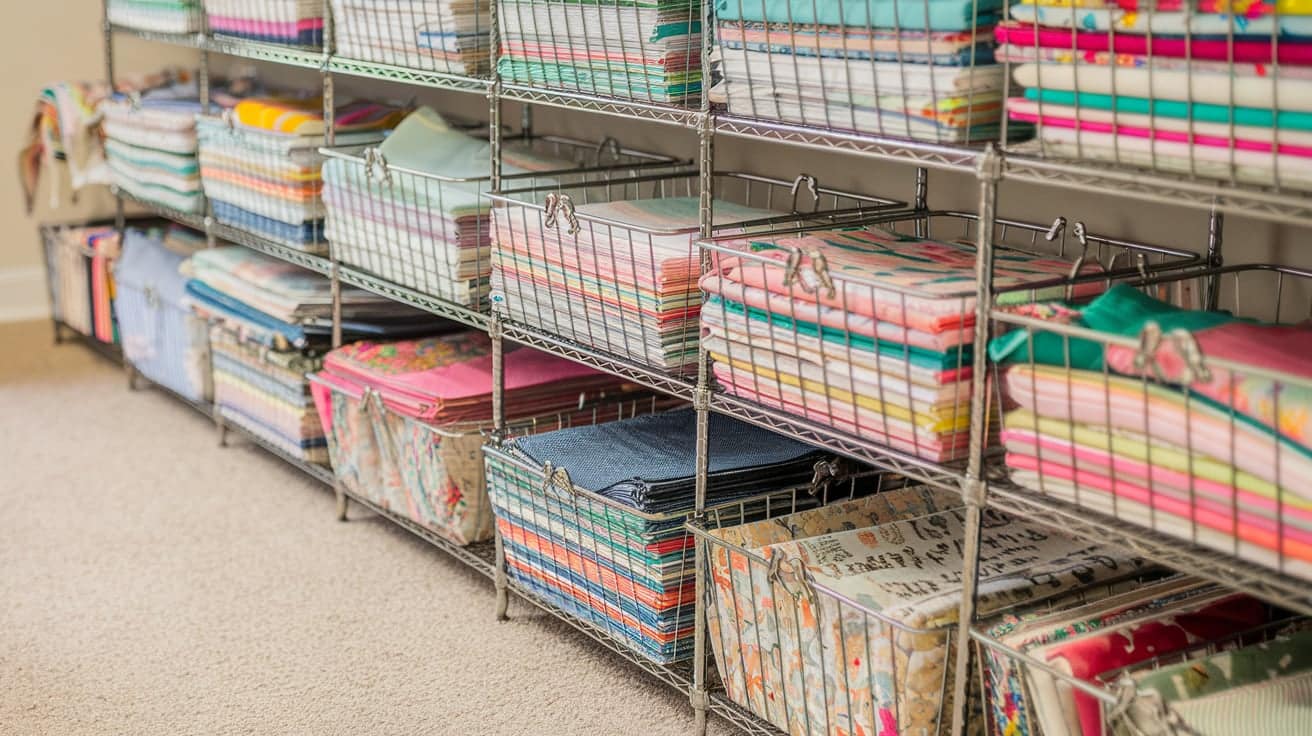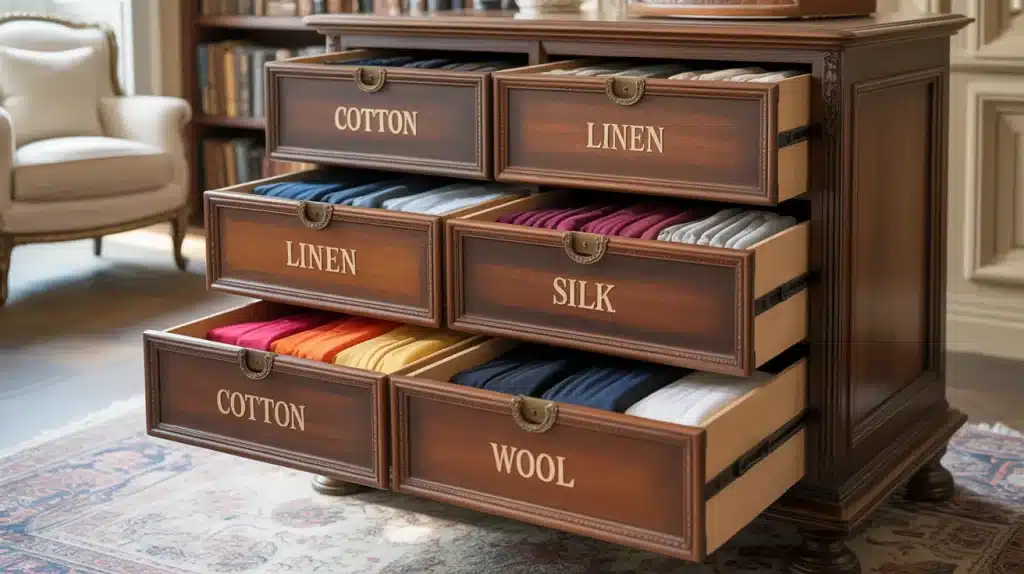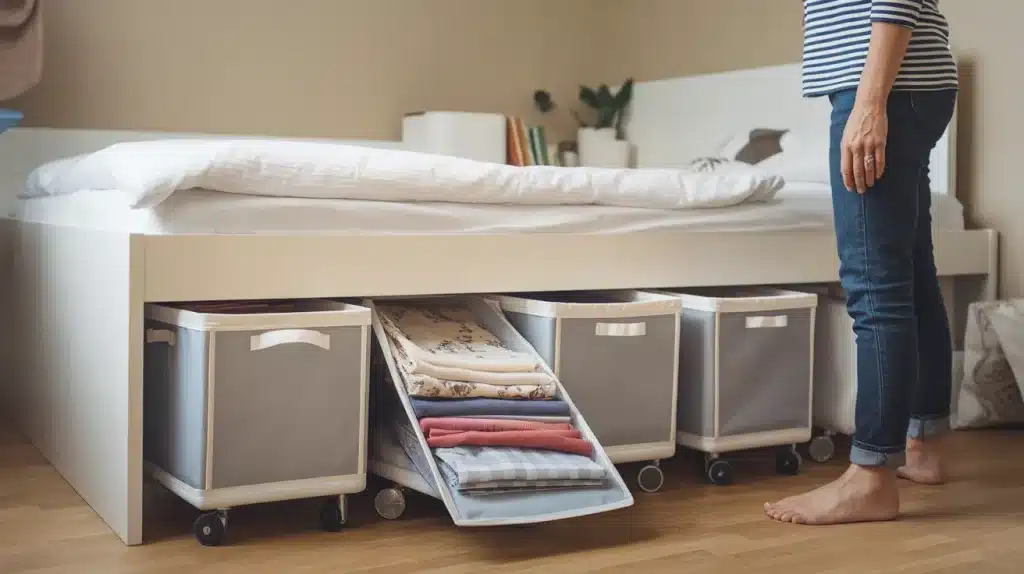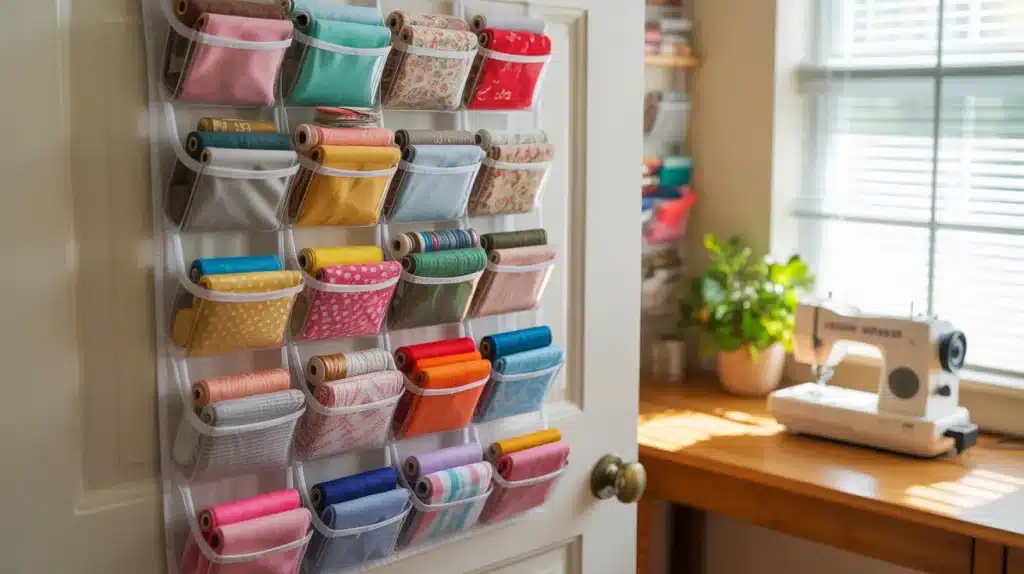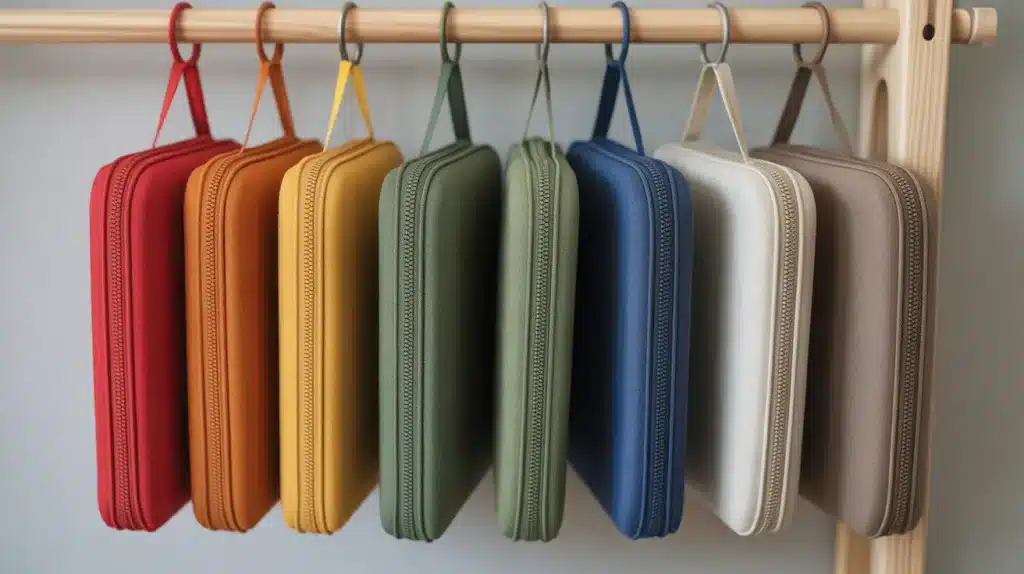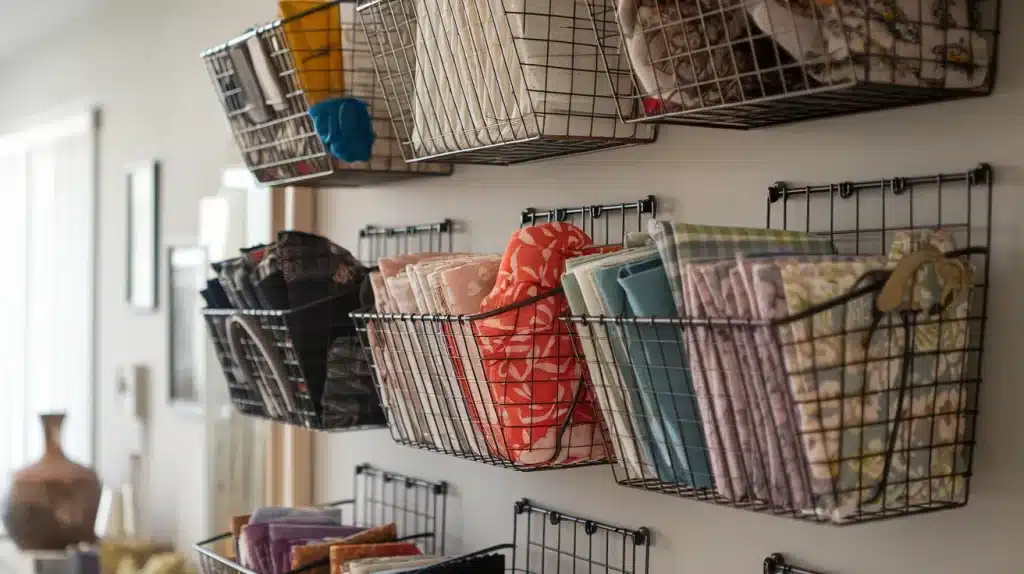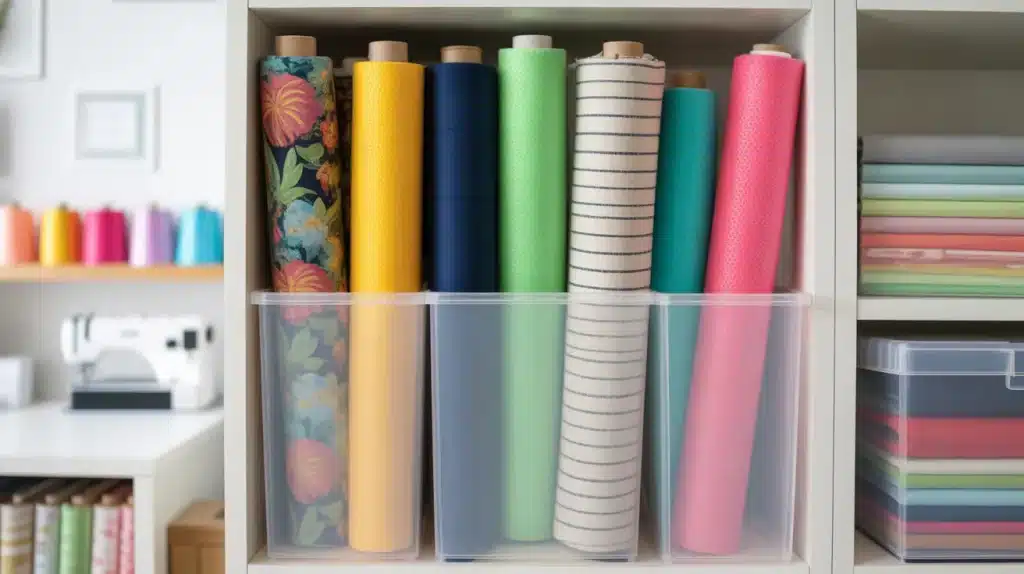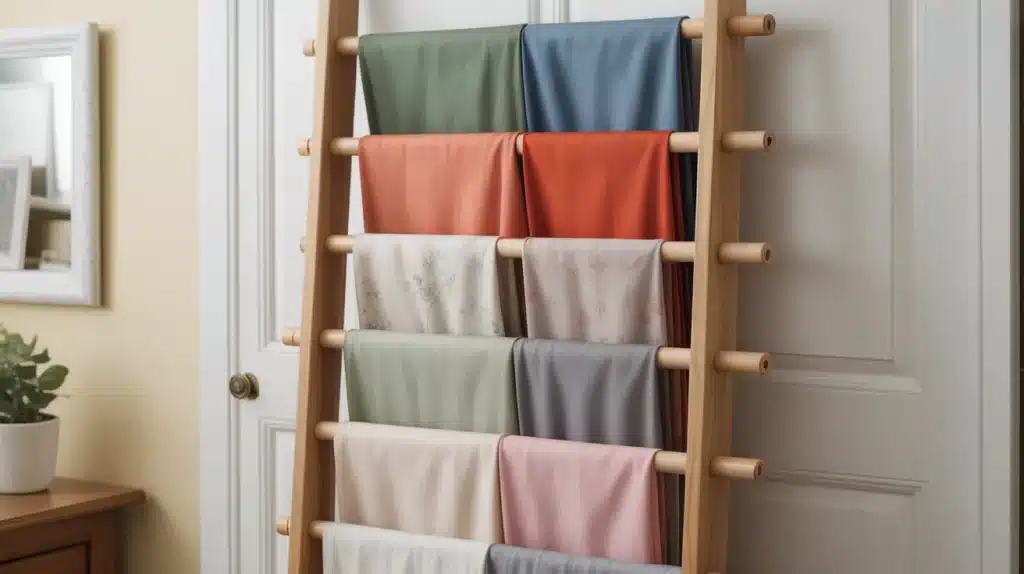Do you spend more time searching for fabric than actually sewing? You’re not alone. Most sewists struggle with fabric storage that quickly turns into chaos.
Wrinkled fabrics, lost pieces, and overflowing bins make creative projects feel overwhelming instead of fun.
Good fabric storage does more than save space. It protects your investment from damage, keeps materials organized by type and color, and makes finding the perfect piece quick and easy.
The right storage system changes your fabric collection into an inspiring and accessible resource.
This guide offers practical storage solutions suitable for any space and budget.
From simple ziplock bags to custom cabinet systems, you’ll find ideas that fit your sewing room, spare closet, or bedroom corner perfectly.
How to Store Fabric Properly?
Proper fabric storage starts with preparation and the right environment. Always wash or prewash your fabric before storing to remove chemicals and prevent shrinkage later.
For folding versus rolling, fold cotton and linen fabrics along the grain to prevent permanent creases. For silk, wool, and stretchy fabrics, roll them around tubes to maintain their shape.
Store your fabric collection in cool, dry places, such as bedroom closets, under-bed storage bins, or dedicated shelving units, away from direct sunlight, humidity, and fabric-eating pests.
Essential storage tools include acid-free tissue paper for wrapping delicate fabrics, clear plastic bins for dust protection and easy viewing, and silica gel packets to absorb excess moisture.
Keep your storage area at a stable temperature and check on your fabrics every few months to ensure they remain in perfect condition for your next sewing project.
Factors to Consider for Fabric Storage
- Space availability: Measure your available closets, drawers, wall space, and room for bins to determine which storage options will fit in your home.
- Size and type of fabric: Small scraps need different solutions than full fabric bolts, and precut fat quarters require different storage than bulky fleece or canvas.
- Frequency of use and visibility: Store your most frequently used fabrics in easily accessible locations with clear visibility, while storing seasonal or special occasion fabrics in less accessible areas.
- Climate and fabric preservation: Select storage methods that safeguard against local climate challenges, including intense sunlight, high humidity, temperature fluctuations, and dust accumulation.
18 Fabric Storage Ideas to Organize Your Collection
Learn practical, creative, and space-saving ways to keep your fabric stash organized and easy to access
1. Accordion-Style Fabric Binder
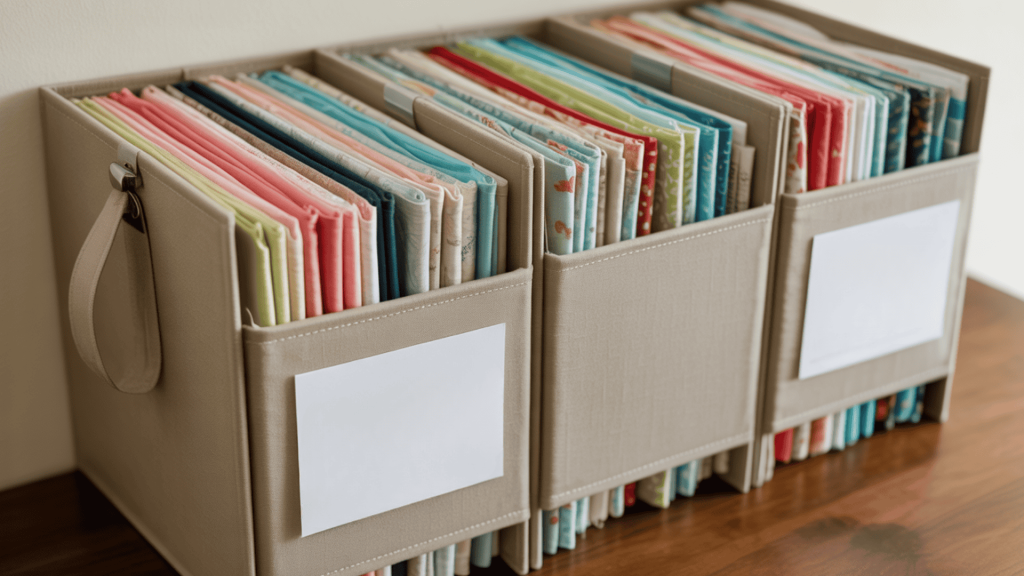
Uses a large expandable folder with oversized pockets to store fabric pieces. Each pocket is assigned to a specific fabric type or project, labeled for easy access.
This method works great for organizing fabric scraps or fat quarters that need detailed sorting and quick retrieval.
2. File Folders in a Filing Cabinet
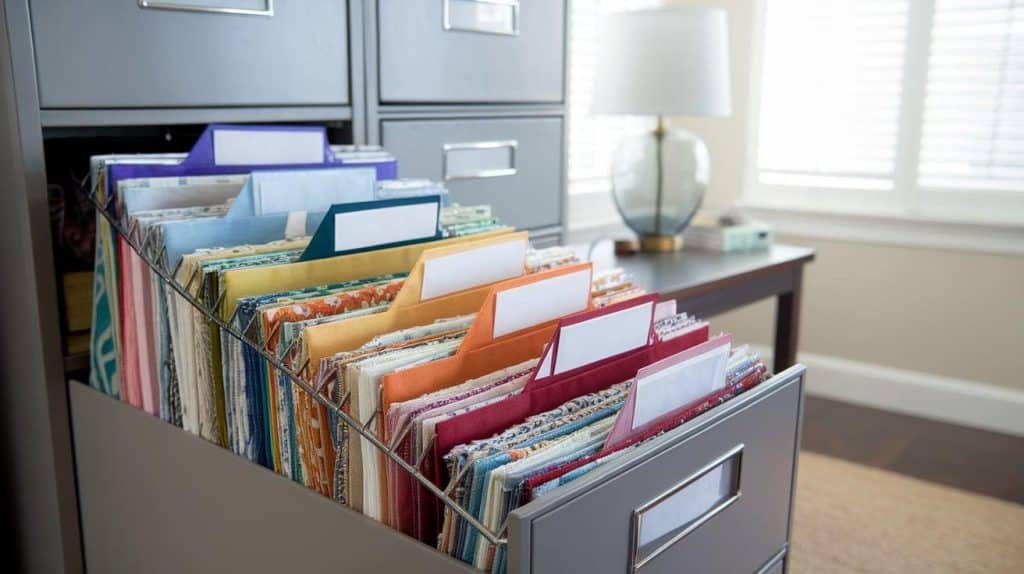
Store fat quarters and smaller fabric pieces in hanging file folders for easy organization. Each folder can hold multiple fabrics sorted by color or project type.
This vertical storage system saves a significant amount of space compared to stacking. You can see everything at a glance without having to dig through piles.
3. Clear Plastic Bins with Labels

Invest in clear storage bins to keep fabrics dust-free while maintaining visibility. Sort fabrics by color, season, or fabric type in separate bins.
Add detailed labels on the front and top of each container. Stack bins on shelves or under tables for maximum space efficiency.
4. IKEA KALLAX Shelves
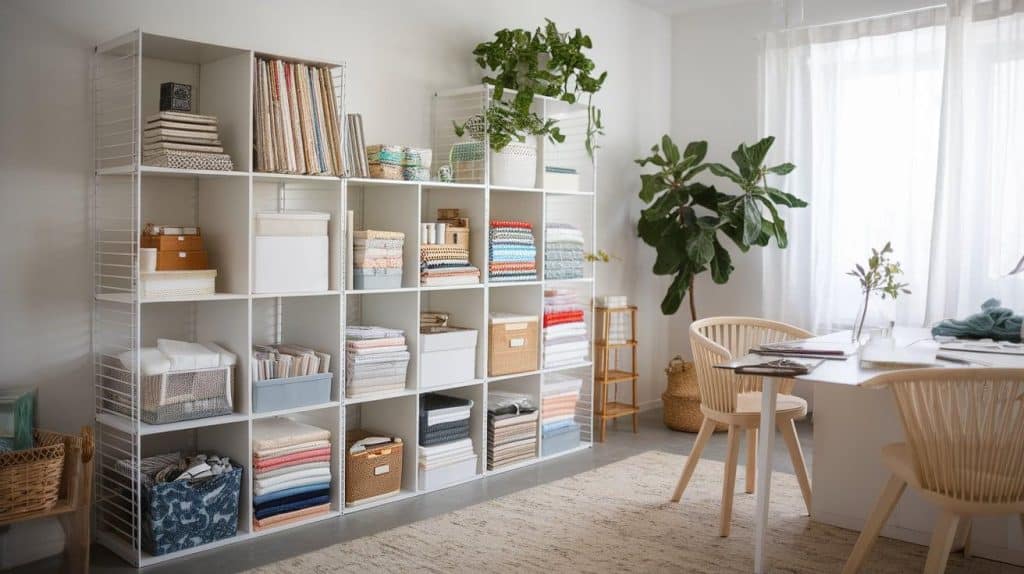
These shelves are perfect for fabric storage and beloved by sewists worldwide. Use fabric bins, baskets, or boxes to organize different categories within each cube.
The open design makes it easy to grab what you need quickly. Mix storage cubes with display cubes to show off your favorite fabrics.
5. Hanging Closet Organizers
Install fabric hanging organizers in your closet for easy access to frequently used materials. Roll or fold yardage and place in individual compartments.
This system works great for current project fabrics or seasonal collections. The compartments keep fabrics separated and wrinkle-free.
6. Modular Drawer Organizer System
Creates order by dedicating each drawer to a specific fabric type, like cotton or silk. Use small bins inside each drawer to sort by color, and label the outside for quick identification.
This method is most effective for medium to extensive fabric collections that require clear material-based separation.
7. Under-Bed Rolling Storage
Use the space under your bed for fabric storage with rolling boxes or drawers. This hidden storage works perfectly for seasonal fabrics or as a backup supply.
Select containers with tight-fitting lids to prevent dust and pests from entering. Rolling wheels make it easy to access everything without the need for heavy lifting.
8. Over-the-Door Organizers
Repurpose clear organizers for small fabric scraps, binding strips, or thread spools. Hang them on closet doors, pantry doors, or sewing room doors.
The transparent pockets let you see everything at once. This solution costs very little but provides lots of organized storage space.
9. Color-Coded Hanging File Pouches
Use zippered portfolio cases in various colors to categorize fabrics. Assign specific colors like red for synthetics, green for natural fibers, and blue for blends to create an instant visual system.
This portable method is ideal for small to medium-sized fabric pieces that require easy sorting and transportation.
10. Ziplock Bags for Scraps by Color
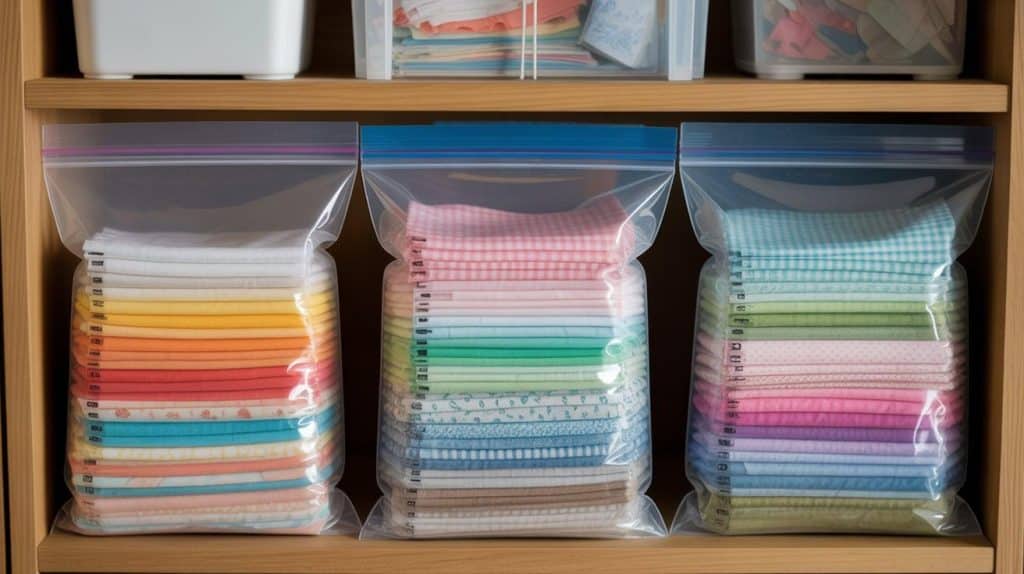
Sort small fabric scraps into gallon-size ziplock bags by color or type of pattern. Press out air before sealing to save space.
Store filled bags in drawers, bins, or on shelves. Label each bag with contents and add new scraps as you create them.
11. Wire Baskets on Wall Hooks
Mount wire baskets on wall hooks for rustic, open-air storage of fabric. This system works well for frequently used fabrics that need good air circulation.
Arrange baskets by color, project, or fabric weight. The open design prevents musty odors and makes selection easy.
12. Fabric Rolled Around Pool Noodles
Prevent creases in significant yardage by rolling fabric around foam pool noodles. This method keeps fabric smooth and wrinkle-free for years.
Store rolled fabrics vertically in tall containers or horizontally on shelves. Pool noodles are inexpensive and work better than cardboard tubes.
13. Magazine Holders for Folded Fat Quarters
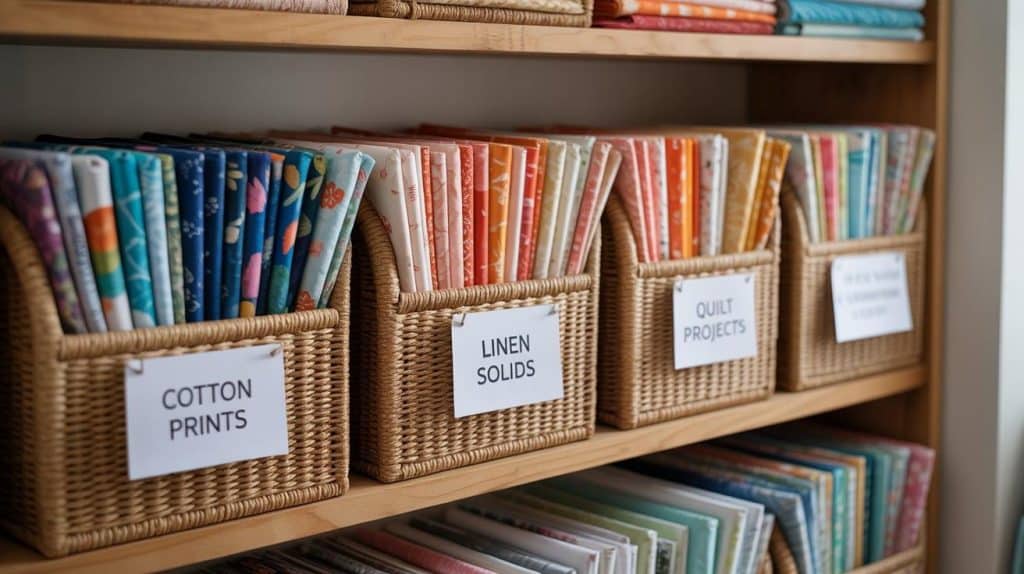
Use magazine holders to store folded fat quarters vertically on shelves. This space-efficient method lets you flip through fabrics like magazines.
Label each holder with fabric type, color, or project designation. The upright storage prevents fabric from getting buried under other pieces.
14. Multi-Bin Rolling Cart with Labeled Compartments
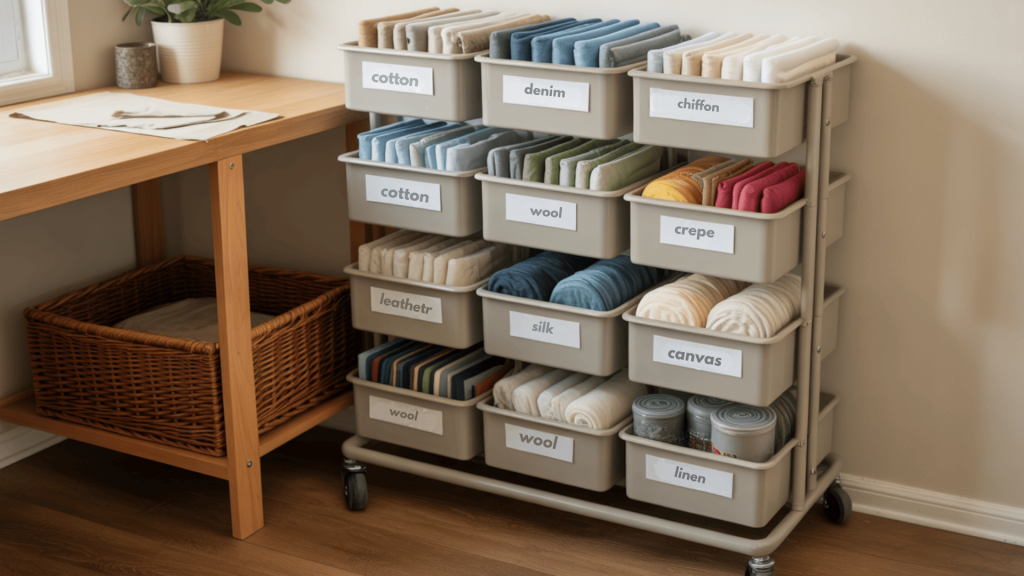
uses a wheeled cart with separate bins for different fabric categories, such as “wool” or “denim.” Each bin handles one fabric type, with optional smaller containers inside for scraps and trims.
This portable solution works perfectly for small spaces where you need to move your organization system around.
15. Pull-Out Drawers in Cabinets
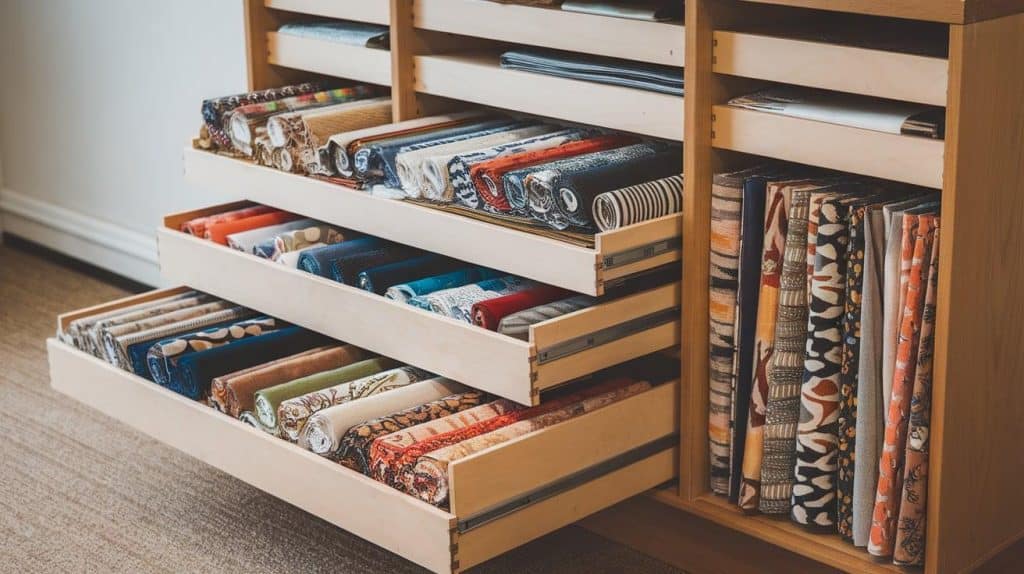
Install pull-out drawers in existing cabinets for easy access to large fabric collections. These drawers glide smoothly, allowing you to see everything without removing items.
Use drawer dividers to separate different fabric types or colors. This solution works better than deep bins for heavy collections.
16. Hanging Pants Hangers
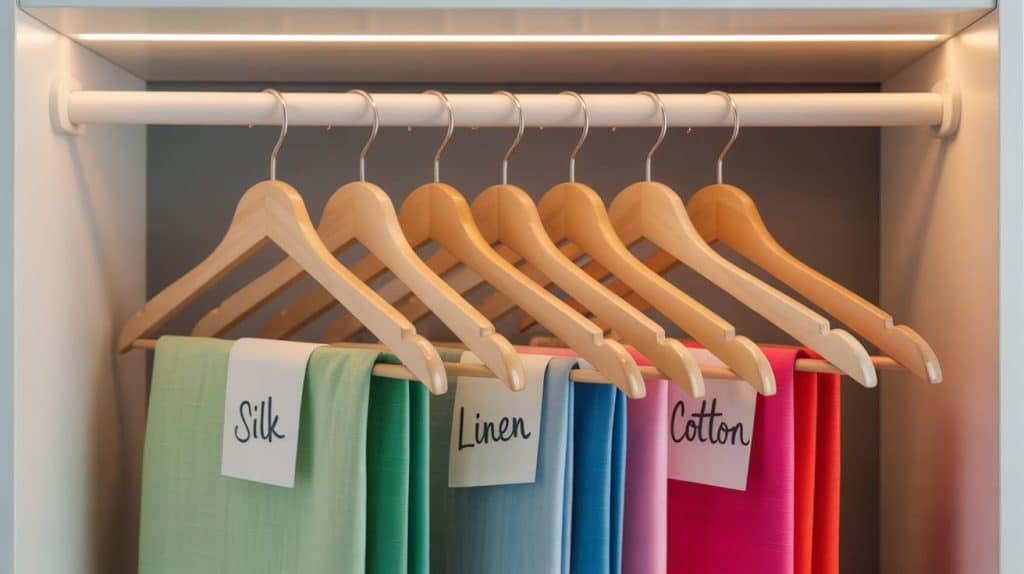
Drape fabric lengths over pants hangers to prevent creases from forming. Use multiple hangers in spare closets or dedicated sewing rooms.
This method works especially well for delicate or easily wrinkled fabrics. Group similar fabrics together and label the hangers with the corresponding fabric information.
17. Fabric Storage Ottoman with Hidden Compartments
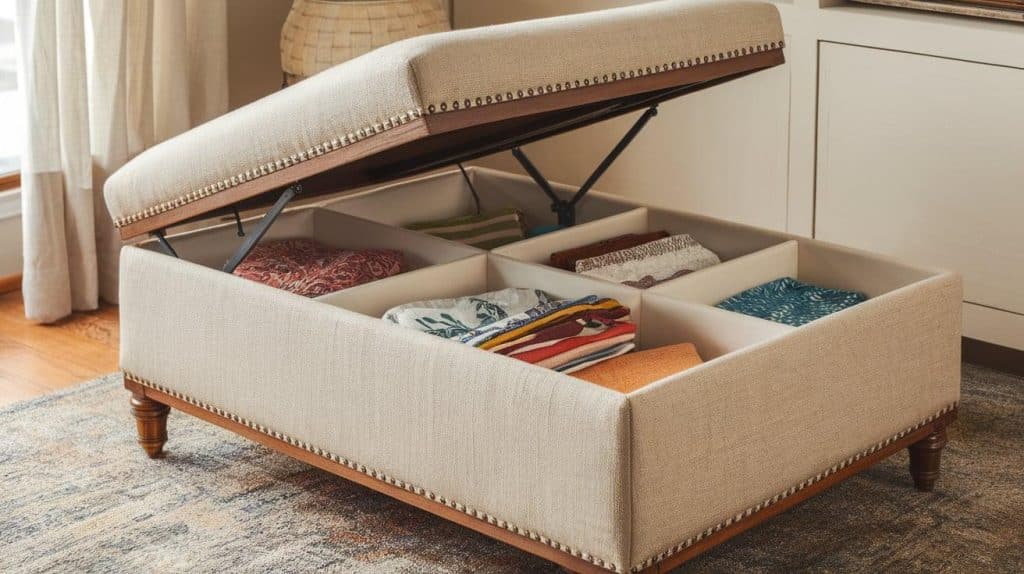
Use storage ottomans or benches with lift-up tops to hide fabric while providing extra seating. These furniture pieces work perfectly in sewing rooms or bedrooms.
Sort fabrics by weight or season inside the compartments. The dual-purpose design saves space while keeping fabrics accessible and free from dust.
18. Expandable Hanging Fabric Ladder
Mounts on walls or doors with fabric pieces folded over individual rungs for display and storage. Each rung represents a distinct fabric category, such as silk, flannel, or voile, for clear visual organization.
This method provides quick access to your fabrics while preventing wrinkles and keeping everything visible at a glance.
Wrapping It Up
Smart fabric storage changes your sewing experience from frustrating to joyful. These storage ideas prove you don’t need a huge budget or a perfect sewing room to stay organized.
Whether you choose comic book boards, clear bins, or digital apps, the key is finding systems that match your space and habits.
Start with one or two storage methods that solve your most significant problems.
Perhaps it’s finally organizing those fabric scraps or creating easy access to your most frequently used materials. Small changes can make a big difference in your creative process.
Your fabric collection should inspire you, not stress you out. Try these storage solutions and spend more time creating beautiful projects instead of hunting for supplies.
Which storage idea will you try first?

